- Oct 27, 2023
Tracking Late Fall Crappie Movements
Learn how the changing season impacts crappie movements in different part of the country and how expert anglers use that understanding to catch more fish this time of year.
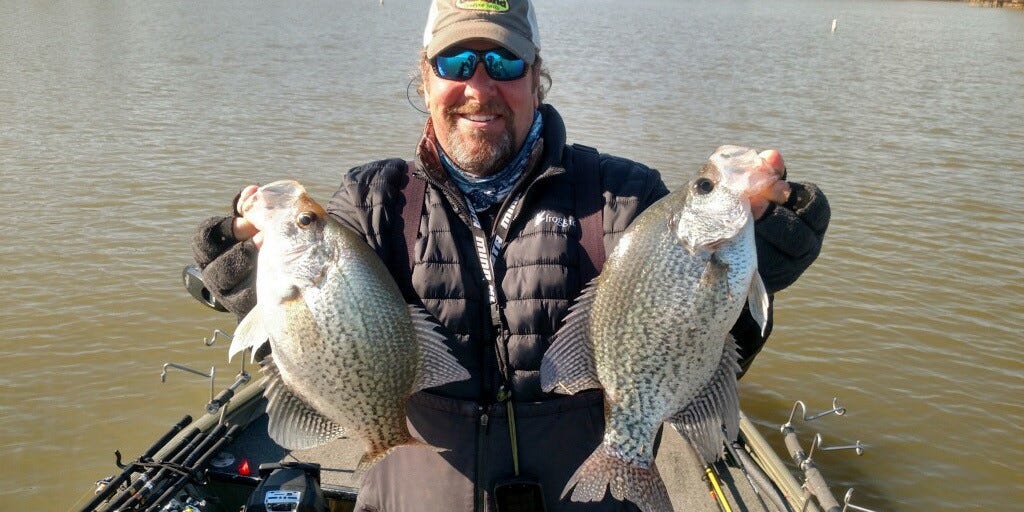

As the shad go in late fall, so go the crappie.
Cold weather and shorter daylight hours during late fall cause water temperatures to continue to drop, triggering baitfish to move to a more suitable comfort zone. Louisiana guide Steve Danna said the crappie will leave cover and follow schools of threadfin shad during the late fall migration. Oklahoma angler Gary Rowe also notices crappie make their move with baitfish when the water temperatures drop on his home waters of Fort Gibson. “We look for the mid 60s for the big move, and it moves the shad too,” he said.
The depth and whereabouts crappie migrate to in late fall depends on where your favorite crappie fishery is located. Here’s a look at how and where crappie experts from different parts of the country – Lee Pitts, Doug Sikora, Rowe and Steve Danna – fish in late autumn for crappie on the move.
Shallow Approach
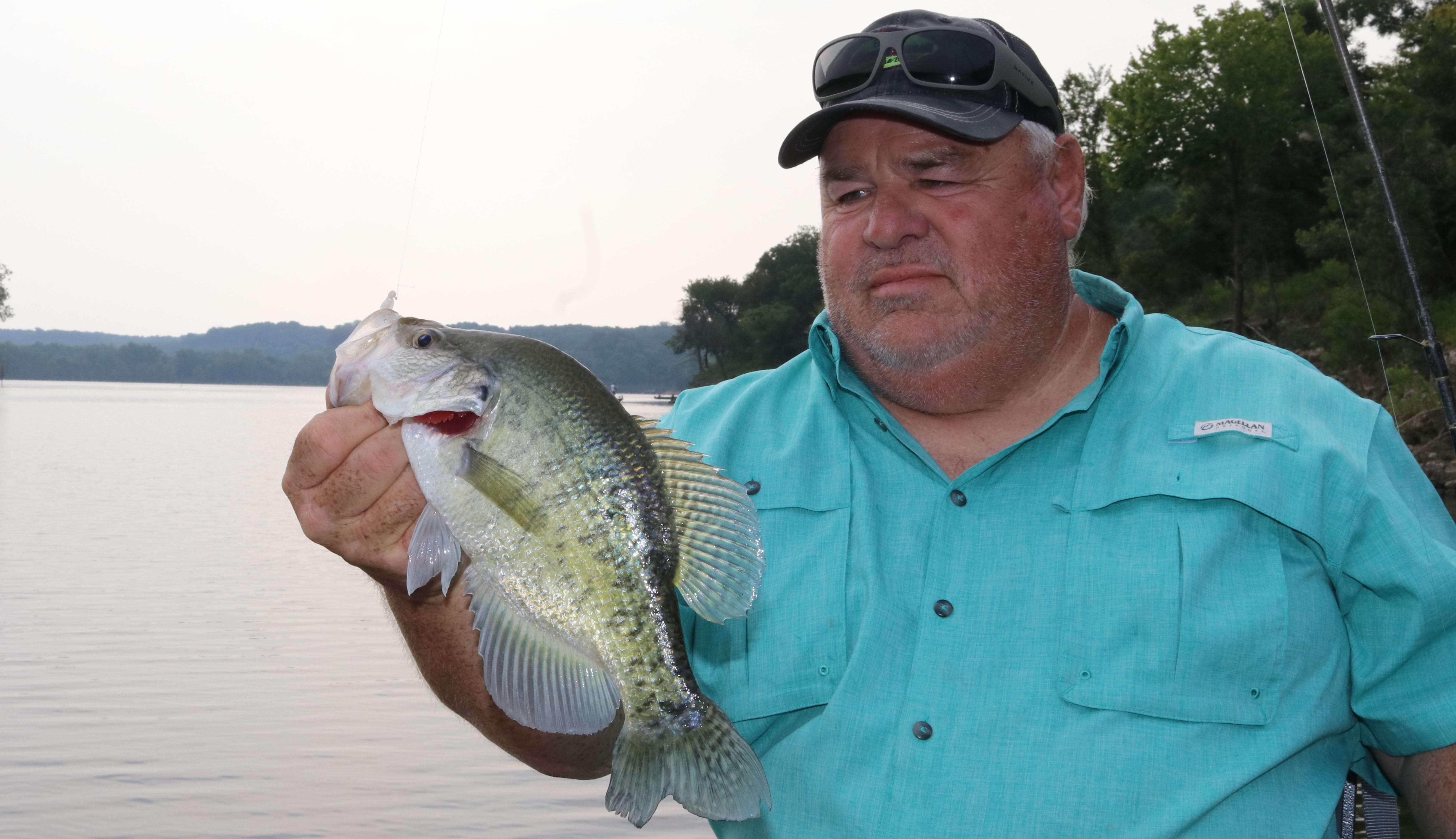

When the water temperature drops into the 60-degree range by late fall in Oklahoma, Rowe finds crappie 2 to 3 feet deep around wood cover.
“They are usually really close to a river or creek channel where there is deeper water,” Rowe said. “I have a tree that goes from about 2 feet of water, and the end of it is about 24 feet deep. This time of the year I go to that tree and I will figure out what depth they are at. I call it my barometer tree because it kind of tells me what I need to know.”
The Oklahoma angler notices brush piles with small limbs usually attract plenty of smaller crappie so he targets larger cover. “The bigger the wood, the bigger the fish to me,” Rowe said. “You may not catch but two or three crappie off of a big log, but they are usually real good fish.”
Rowe tempts shallow crappie with a Bobby Garland Baby Shad Swim’R (Bone White/Chartreuse or Cajun Cricket) on a 1/16-ounce jighead. If he notices shallow crappie are finicky he will scale down to an Itty Bit Slab Hunt’R on a 1/48-ounce jig and a small split shot set about 1 foot above the bait.
Casting to the cover and retrieving his lure at a steady pace triggers strikes from active crappie hanging around the shallow wood. If Rowe notices crappie are holding tight to the cover, he uses a 10- or 11-foot crappie pole to dip his lure next to the log and deadstick the bait until a fish bites.
Winter Staging
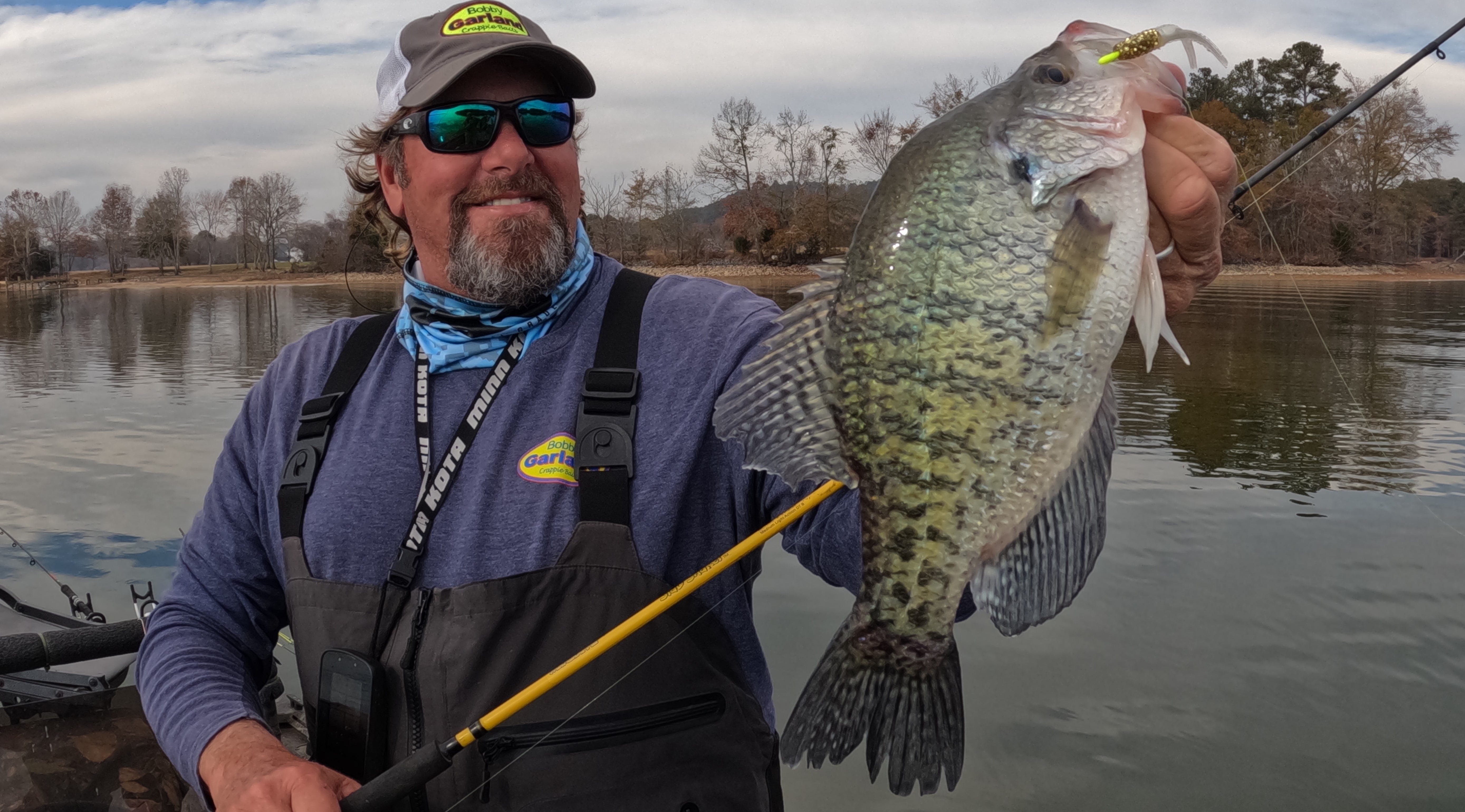

“A lot of times here in Alabama these fish in late November and early December start staging up getting ready to go into (winter) places,” Alabama guide Lee Pitts said.
When fishing the Alabama lakes of Guntersville, Weiss and Neely Henry in late fall, Pitts finds crappie migrating to the deep creek troughs where the fish will stage for winter. The crappie move more vertically than horizontally in the water column as the fish follow shad. “There are several times when my boat is sitting in 20 to 25 feet of water and I am showing a giant school of crappie in 8 to 10 feet,” Pitts said.
Current on the reservoirs in late fall can cause crappie to position in different places. “That time of year the fish don’t want to exert a whole lot of energy,” Pitts said. “They can lay behind a current break or an eddy so that is where they are going to be then.”
Long-line trolling catches some staging crappie in the creek troughs during this time, but Pitts prefers the float-and-fly technique to keep his lures in the strike zone longer. “The schools are moving a lot and they do not want to chase a whole lot, so that is why I love that float and fly,” Pitts said.
Pitts usually sets his float at about 7 1/2 to 8 feet up his line and ties on a 1/32-ounce jig with a Baby Shad or a 1/16-ounce jig with an Itty Bit Slab Slay’R to complete his float-and-fly rig. His favorite colors for the Baby Shad and Itty Bit Slab Slay’R include Monkey Milk, Blue Ice, Bluegrass and Lights Out.
Once he locates a school of crappie with his electronics, Pitts casts his float-and-fly rig to the fish and lets it sit still. He occasionally slightly pulls the float so it will quiver. The light jigheads cause the Baby Shad or Itty Bit Slab Slay’R to fall at a 90-degree angle, creating more tail action to the lure. “A heavier bait will fall too quick and won’t get the same action,” Pitts said.
Targeting Creek Channels
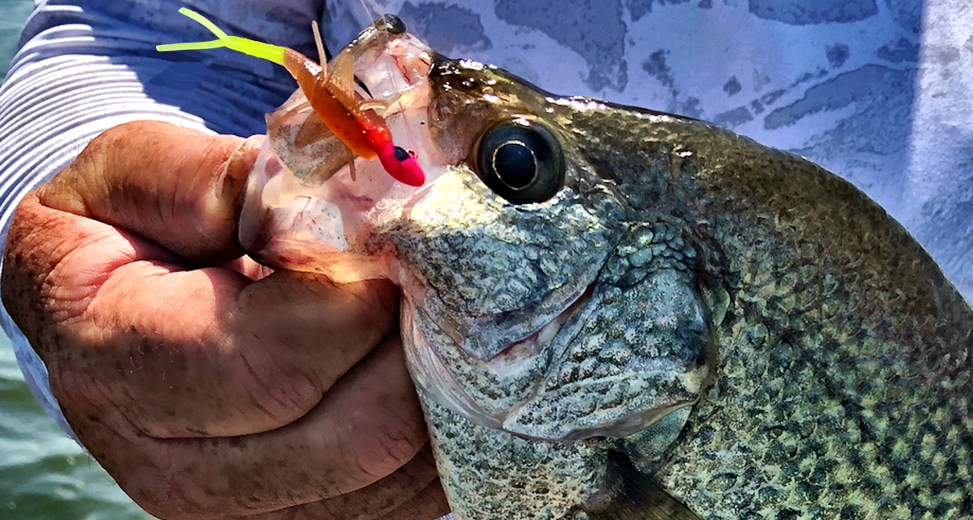

Louisiana guide Steve Danna notices the late fall crappie migration starts on his home waters of Lake D’Arbonne “when the air temperature gets in the mid 70s and the water temperature gets in the low 70s.”
Crappie move from their early fall spots at the edges of creek channels into the channel and suspend over the deepest part of the channel by late fall. The threadfin shad and crappie will stay in the channel at various depths throughout late fall and winter.
Relying on his forward-facing sonar, Danna finds a layer of shad with a layer of crappie holding below the baitfish at depths from 5 to 12 feet over 30 feet of water. “I call those crappie roamers, and normally when I chase them, they are bigger fish,” Danna said. “That is something we didn’t know about until LiveScope came out.”
Danna’s favorite lures for imitating threadfin shad in late fall are the 2- and 3-inch Slab Slay’R and the Mayfly. “That Mayfly is an awesome bait,” Danna said. “The diameter of the bait and how it looks on a jighead motivates the bite.”
Danna’s favorite lure colors are Black/Hot Pink, Cajun Cricket, Bluegrass, Pumpkinseed/Pearl Chartreuse and Junebug/ Pearl Chartreuse. Danna fishes his Slab Slay’Rs and Mayflies on 1/8- and 1/4-ounce jigheads for his late fall tactics.
Forward facing sonar allows Danna to locate the suspended crappie, pitch his jig on a 14-foot rod to the fish, and put the lure “right on top of its head.” If the falling jig fails to trigger a bite, Danna lets the lure pendulum back to the boat before making another pitch.
Monitoring Water Clarity
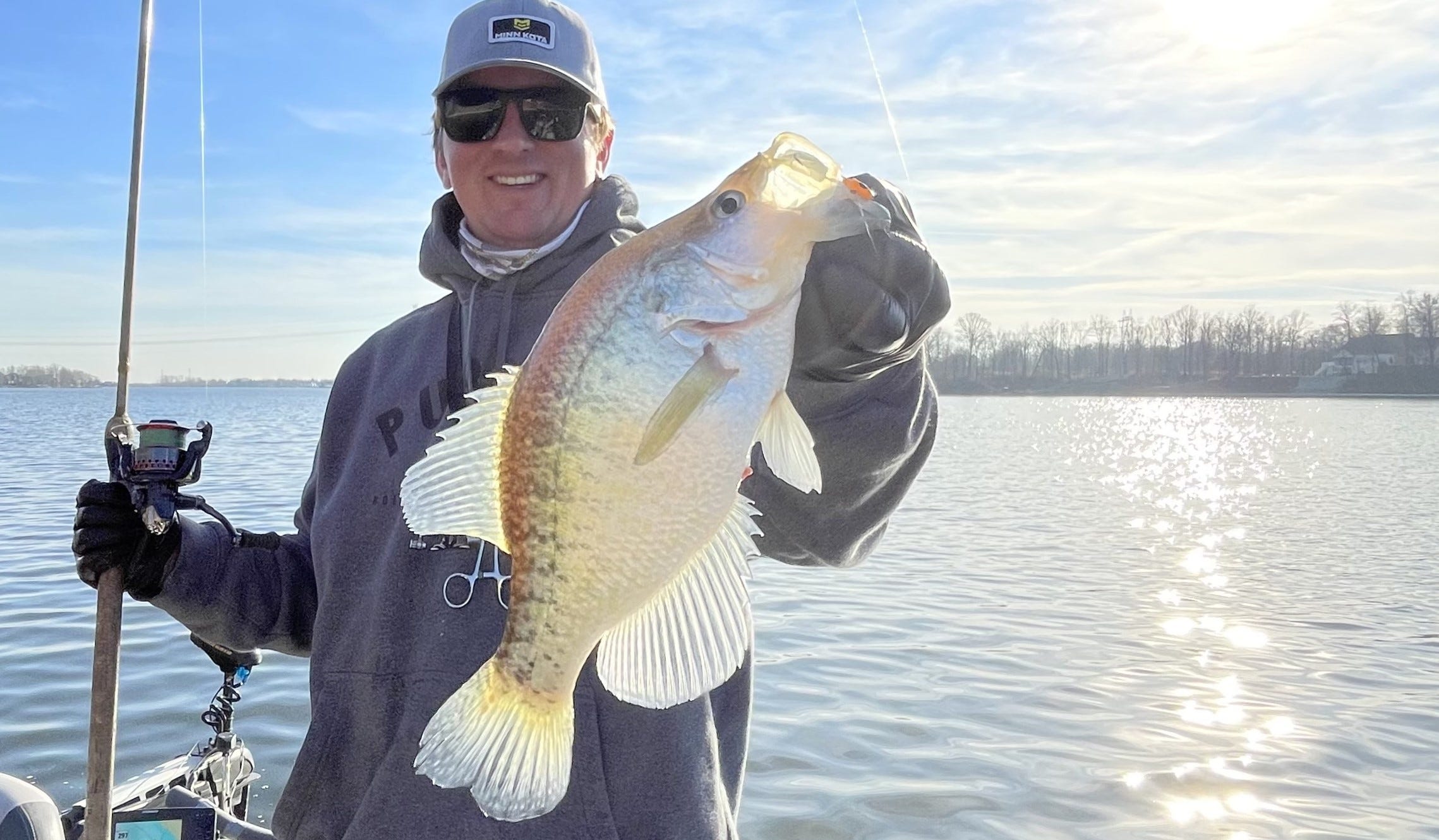

Indiana tournament angler Doug Sikora said water temperature and gizzard shad movement are keys to locating late fall crappie, but he also suggests paying attention to water clarity.
“If the water is muddy, crappie go shallow. If it gets muddy the sun heats that muddy water,” Sikora said, noting that the heated muddy water draws crappie as shallow as 2 feet near the bank no matter how cold the air temperature gets.
“If we have super clear water the fish are never shallow. Crappie will stay on the deeper channel ledges with cover,” Sikora said, pointing toward old stump rows and manmade cover as the types of cover he looks for. If the water is clear, he expects to find crappie in 13 feet to 30 feet.
Current also plays a role in where crappie relocate in late fall. “Crappie are a very fragile fish when it comes to cold moving water,” Sikora said, noting crappie will move behind anything that breaks the current or to the side of a creek with the slowest water flow.
Deadsticking a pearl Minnow Mind’R on a 1/8-ounce Mo’ Glo pink or blue jig is Sikora’s lure choice for late fall crappie. He also applies Mo’ Glo Slab Jam underneath the lure’s tail to make it glow better during low-light conditions. The Baby Shad Swim’R and the 2-inch Slab Slay’R in Mo’ Glo Sunset, Electric Chicken and Glitter Critter are other baits Sikora opts for to catch late fall crappie.
Sikora estimates he employs a vertical jigging presentation about 90 percent of the time for crappie holding along channel ledges in late fall. He will also shoot his baits on 1/24-ounce jigs under docks where crappie usually bite as the lure descends.
Warm Snap Effects
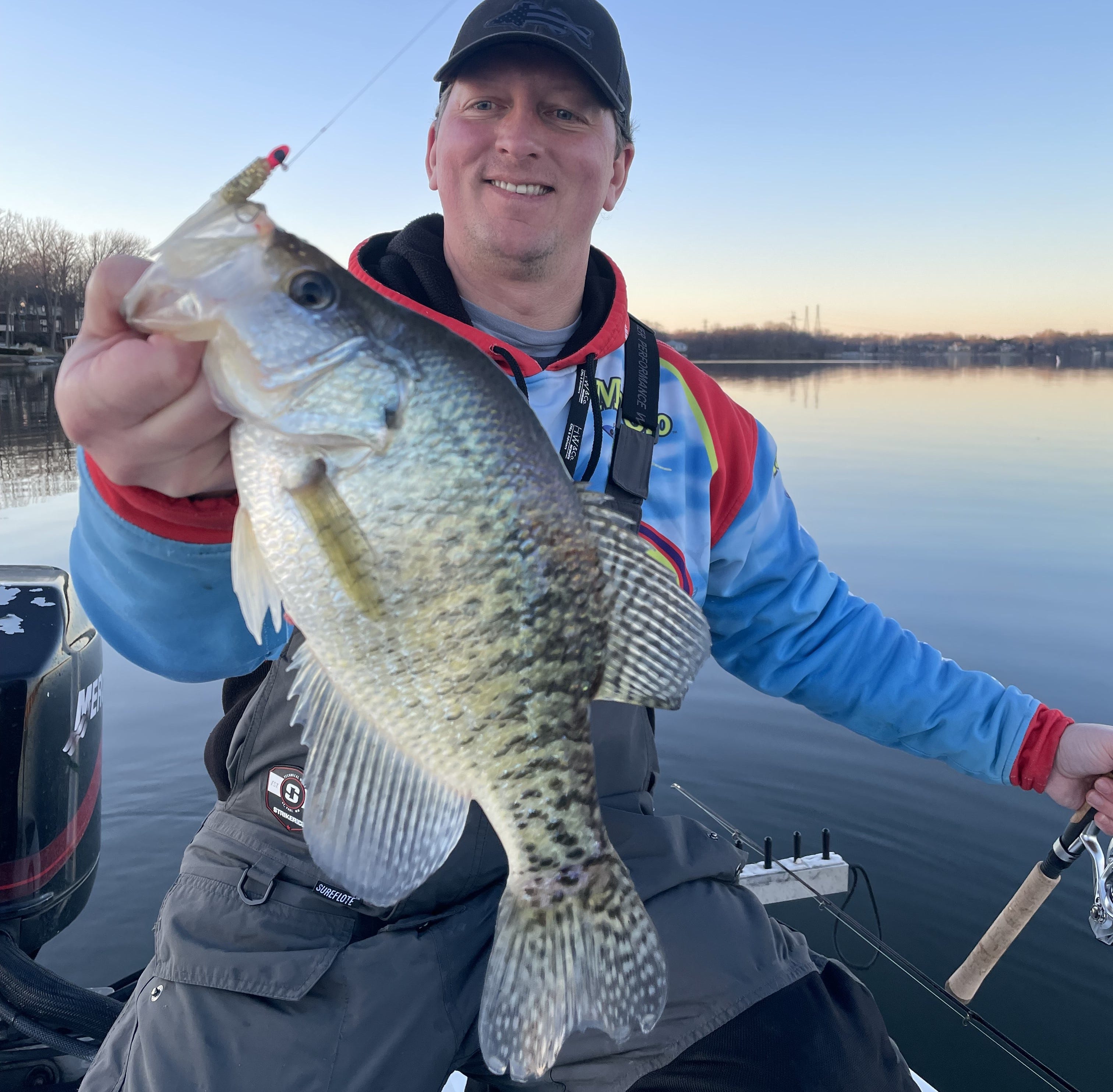

The warm, calm and hazy weather of late autumn known as Indian summer has the following effects on the movement of crappie.
- When warm weather continues to dominate in late fall, Gary Rowe notices crappie on his home waters of Fort Gibson Lake in Oklahoma tend to back off into deeper water.
- Late warm spell on Lee Pitts’ home lakes in Alabama cause suspending crappie to move up in the water column, within a couple of feet of the surface sometimes.
- Crappie become finicky and spread out off ledges on Lake D’Arbonne in Louisiana during Indian summer periods. Steve Danna notices the shad move back to the flats in feeder creeks where the crappie follow the bait.
- Doug Sikora finds Indian summer crappie hanging out around deep docks at Indiana reservoirs. Rusty poles on docks are Sikora’s favorite targets in this situation. “I don’t care as much about the shade,” he said. “I care about the rusty pole because the sun keeps the algae on that rusty pole longer in an Indian summer, which then drives the baitfish to the pole to eat the algae, which then drives the crappie to the poles.”



